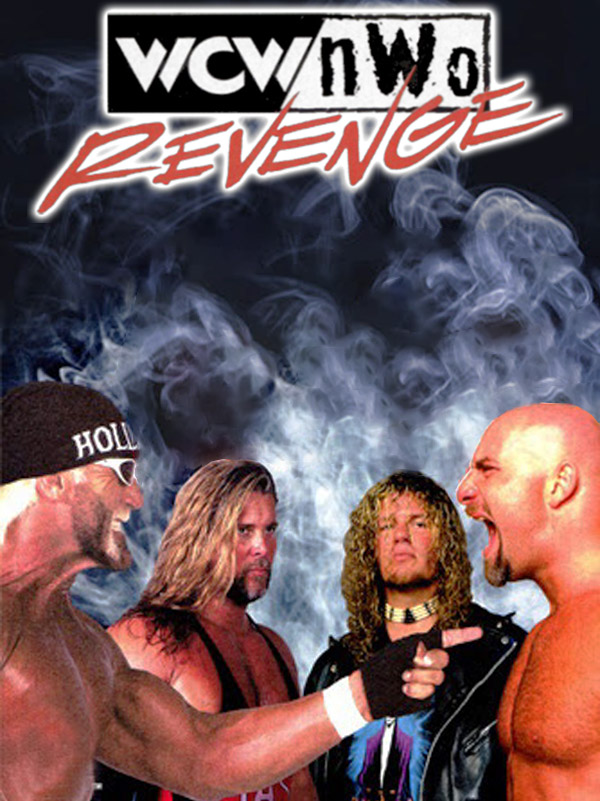So, what is Kanyon’s Corner? In short, a speedrunning technique that I developed for the World Heavyweight, U.S. Heavyweight, and T.V. Title categories in WCW/nWo Revenge. It involves selecting Kanyon (or his alter ego/persona, Mortis) and executing a series of repeated move cycles within one of the four corner turnbuckles that stunlocks the opponent and rapidly depletes his stamina (while simultaneously boosting your wrestler’s Spirit meter), ultimately leading to a pinfall victory. When executed precisely and with minimal interruption across a standard nine match tournament, it can bring the overall RTA times for the above three championship categories down to under six minutes each!
In greater detail, for the majority of opponents, Kanyon’s Corner entails initiating a front weak grapple as quickly as possible at the start of the match, whipping one’s opponent into any of the four turnbuckles, and executing five consecutive cycles of a running splash to the stunned opponent in the turnbuckle (causing him to stumble outward) followed immediately by a Muay Thai Roundhouse kick (that sends him hurtling back into the turnbuckle). After the last full cycle is complete, one final running turnbuckle splash is performed and immediately followed up with a front strong grapple and a Northern Lights suplex with a bridge for the pinning combination.
Shortfalls:
As noted in the section covering RNG below, whether or not any particular opponent remains upright for the full Kanyon’s Corner sequence appears to be random. An opponent getting knocked down after one of the Muay Thai Roundhouse kicks won’t typically detract from the overall effectiveness of Kanyon’s Corner when it comes to attaining victory, as you can simply pick them right back up and resume the sequence where you left off. However, each time an opponent hits the canvas, it takes somewhere between four to six seconds to get things rolling again, which will be a hit ultimately seen in your splits.
For Kanyon’s Corner to work optimally and position you properly for the Northern Lights suplex pinfall finish, your character should be centered as much as possible when executing the repeated turnbuckle splash/Muay Thai Roundhouse combos. Failure to do so can result in an opponent either not stumbling completely back to the turnbuckle (breaking the stunlock) or causing a misfire on the final front strong grapple attempt (resulting in either a missed grapple or a back strong grapple that produces a rollup pin attempt that fails more often than not). If at any point you notice that your character is off center, it would be advisable to sacrifice the extra second needed to recenter him.
Kanyon’s Corner is also an effective strategy for success in the Tag Team tournament, but to a lesser extent than in the singles championship tournaments if you are playing the single player mode (with the AI acting as your tag team partner). In that particular case, your viable corner turnbuckle options fall from four to two, as your opponent’s tag team partner is in one corner (where a tag can be made) and your AI controlled partner (who loves to break the stunlock by grabbing or hitting your corner-bound opponent) is in the other. Thus, for optimal results, it is best to use either of the neutral corners (top left or bottom right) for applying the Kanyon’s Corner technique. Moreover, and often more frustratingly, your AI controlled partner will frequently fail to intercept your pinned opponent’s partner before he breaks up the pinfall attempt. This can lead to longer than expected match times due to having to perform multiple pinning sequences while trying to position your partner between you and your opponent’s partner.
Kanyon’s Corner is not applicable to the Cruiserweight tournament category, as Kanyon/Mortis is ineligible for selection for that particular championship within the game itself.
Observed RNG Factors:
The opponent selection and order for matches one through eight shuffles with almost every attempt. Occasionally, you will get consecutive attempts where the starting foe and opponent ladder repeat, but there doesn’t appear to be any discernible pattern to it. Only the final opponent (the reigning champion if challenging for the belt or previous champion if defending the belt) in the ninth match appears consistently with each attempt.
Whether or not an opponent starts a match running versus walking.
Whether or not an opponent stays upright for the entirety of Kanyon’s Corner. From observation, some opponents tend to get knocked down more frequently than others (e.g. The Cruiserweights, Lex Luger, DDP, Scott Hall, and Booker T.), but all are capable of making it through the full series of splashes and kicks to the Northern Lights suplex without falling.
Whether or not an opponent attempts a grapple of his own at the start (frequently yielding a time-killing “test of strength” when paired with your initial grapple attempt), or if he reverses or blocks the initial Irish whip to the turnbuckle attempt.
Additional Notes Pertaining To One Player Tag Team Tournament Attempts:
As mentioned in the third point of the “Shortfalls” section above, your AI controlled tag team partner will likely be the biggest obstacle to overcome. Specifically, when you need him the most, he will frequently let you down by:
- Entering the ring but failing to intercept the opposing teammate before he breaks up your pinfall attempt with a stomp.
- Not entering the ring at all, leaving you to momentarily fend for yourself against two opponents.
- Attempting to pin your downed opponent, even though he isn’t eligible to score the pin.
- Missing an attempted strike on the opponent and accidentally hitting your wrestler.
- Forcing a tag with your character at the start of the match, which requires you to temporarily assume control of his character until he returns your original character to the apron where you can make another tag.
Bottomline, your AI controlled partner is painfully dumb, and you will frequently have to time your offense in such a way as to either trick him into helping you get the win (e.g. timing your pin attempt for whenever he is in the ring and positioned directly in front of your opponent’s partner so that they bump into each other repeatedly during the three count) or eliminate the need for his assistance outright (e.g. setting up the final Northern Lights suplex so that your pinned opponent’s outstretched body blocks his partner from making the save).
While not as utterly brainless as your AI partner, your opponent’s partner is also capable of the following, seemingly random, gaffes:
-Being late to enter during a pinfall attempt because he is in the middle of performing an apron taunt. -Getting in and making it over to your position in time but for some reason, opting not to break-up the pinfall attempt. Some wrestlers appear to do this more often than others (looking at you, Alex Wright).
Drawing an opposing team with a very tall partner on the apron (e.g. Reese) can be helpful, as their typical ring entry method is to step over the top rope, which takes significantly more time than the standard between the ropes entry.
Unlike the other championships, the Tag Team tournament's opposing team ladder can be either randomly shuffled (for matches one through eight) with each attempt or kept static based on your character choices. I have done a much deeper dive on this subject, and my findings have been documented here:
https://www.speedrun.com/wcwnwo_revenge/guide/eky8h
Problematic Wrestlers & Trolls:
Kevin Nash: He does not take well to the Kanyon’s Corner technique, as he frequently fails to stumble fully back into the turnbuckle after a Muay Thai Roundhouse kick. Kanyon’s Corner can be pulled off on him, but it has to be very well aligned and it typically takes more time to execute. Also, he has a tendency to reverse Irish whips and grapples more than most others.
The Giant: Similar to Nash but to a lesser degree, The Giant’s size requires precise alignment to maintain the Kanyon’s Corner sequence and it can take more time to fully execute than on a standard opponent.
Chris Benoit & Rick Steiner: Apparently, they have better than average endurance, as it typically requires one additional turnbuckle splash and Muay Thai Roundhouse kick cycle to ensure a pinfall victory. If you perform the standard five turnbuckle splash/Muay Thai Roundhouse kick cycles followed by one last splash and the Northern Lights suplex, these two will frequently kick out just before the decisive third count.
Curt Hennig, Scott Hall, Chris Jericho, & Alex Wright: Will occasionally block the finishing Northern Lights suplex by delivering a knee strike to the midsection.
Raven, Saturn, Bret Hart, & Diamond Dallas Page: They seem to have a higher propensity for blocking the initial Irish whip attempts as they reach the turnbuckle, and in general, a greater tendency for reversals.
Area For Potential Time Saves:
Setting up Eric Bischoff as the champion to beat for the World Heavyweight, U.S. Heavyweight, T.V. Title, and World Tag Team tournaments (he’s ineligible for the Cruiserweight tournament). From observation during play, Bischoff appears to be the selectable character with the lowest endurance, and thus, he succumbs to the Kanyon’s Corner technique in one less cycle than the majority of the roster. Moreover, his offense consists solely of strikes, so there is no concern to be had regarding grapple attempts on his part. The only potential downside to choosing Bischoff as your fixed final opponent is that he is not the most reliable when it comes to staying upright for the entire Kanyon’s Corner sequence. As noted in the “Shortfalls” section above, each time an opponent falls down, the time loss due to having to pick him back up and resume the sequence is usually in the 4-6 seconds range, so having Bischoff as the final opponent (versus an opponent that has a lesser tendency to fall) is a risky gambit.
Miscellaneous:
So, some might question, “Wouldn’t this same technique work for Glacier?” The short answer is, yes. He has a strong striking kick and the same turnbuckle splash and Northern Lights suplex as Kanyon. However, while fast and effective, Glacier’s thrust kick moves him off center with the turnbuckle upon each completion, and unless adjusted, his misalignment continues to worsen with each repeated cycle. Thus, time must be frequently sacrificed to realign his position in order to avoid the potential complications noted in the second point of the above “Shortfalls” section. Furthermore, when complications arise (e.g. during the Tag Team tournament matches), I have found Kanyon’s top turnbuckle splash to be a helpful part of my backup strategy. Glacier, sadly, has no standard top turnbuckle maneuver other than a taunt. So, in summation, while it is possible to use the Kanyon’s Corner technique with Glacier, the increased potential for additional complications coupled with his moveset limitations make Glacier the less desirable option in my assessment.





